The Most Outstanding And Influential Kung-Fu Martial Arts In The World
The Most Outstanding And Influential Kung-Fu Martial Arts In The World
1.Wushu is a martial art and a full-contact sport. It was developed in China after 1949, in an effort to standardize the practice of traditional Chinese martial arts, although attempts to structure the various decentralized martial arts traditions date back earlier, when the Central Guoshu Institute was established at Nanking in 1928. For More Information about Wushu Click Here.
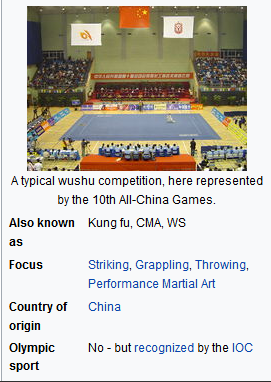
2.Karate is a martial art developed in the Ryukyu Kingdom. It developed from the indigenous Ryukyuan martial arts under the influence of Chinese Kung Fu, particularly Fujian White Crane. Karate is now predominantly a striking art using punching, kicking, knee strikes, elbow strikes and open-hand techniques such as knife-hands, spear-hands, and palm-heel strikes. Historically, and in some modern styles, grappling, throws, joint locks, restraints, and vital-point strikes are also taught. A karate practitioner is called a karateka For More Information about Karate Click Here.
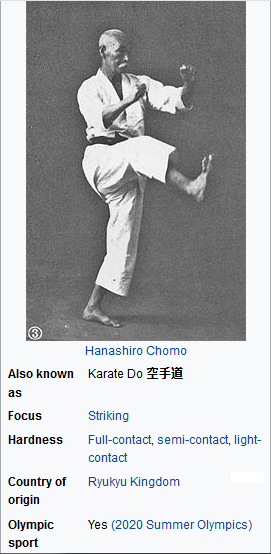
3.Shaolin Kung Fu also called Shaolin Wushu or Shaolin quan is one of the oldest, largest, and most famous styles of wushu or kungfu. It combines Zen Buddhism and martial arts and originated and was developed in the Shaolin temple in Henan province, China during its 1500-year history. Popular sayings in Chinese folklore related to this practice include "All martial arts under heaven originated from Shaolin" and "Shaolin kung fu is the best under heaven," indicating the influence of Shaolin kung fu among martial arts. The name Shaolin is also used as a brand for the so-called external styles of kung fu. Many styles in southern and northern China use the name Shaolin, For More Information about Shaolin Kung Fu Click Here.
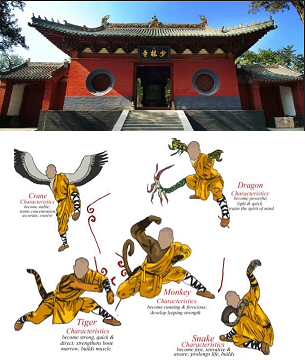
4.Wing Chun is a traditional Southern Chinese Kung fu (wushu) specializing in close range combat, For More Information about Wing Chun Click Here.
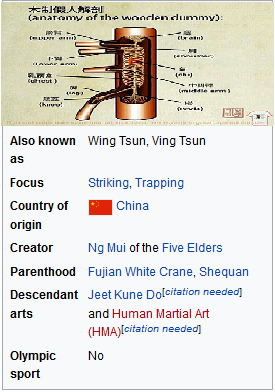
5.Taekwondo is a Korean martial art, characterised by its emphasis on head-height kicks, jumping and spinning kicks, and fast kicking techniques, For More Information about Taekwondo Click Here.
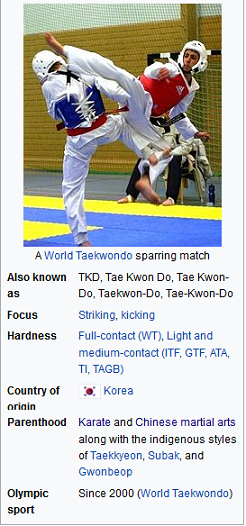
6.Krav Maga is a military self-defence and fighting system developed for the Israel Defense Forces (IDF) and Israeli security forces (Shin Bet and Mossad) that derived from a combination of techniques sourced from boxing, wrestling, aikido, judo and karate, along with realistic fight training, For More Information about Krav Maga Click Here.
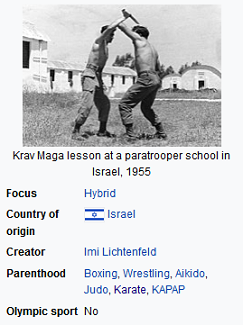
7.Brazilian jiu-jitsu is a martial art and combat sport system that focuses on grappling and especially ground fighting. Brazilian jiu-jitsu was formed from Kodokan judo ground fighting (newaza) fundamentals that were taught by a number of individuals including Takeo Yano, Mitsuyo Maeda and Soshihiro Satake. Brazilian jiu-jitsu eventually came to be its own combat sport through the experiments, practices, and adaptation of judo through Carlos and Hélio Gracie (who passed their knowledge on to their extended family) as well as other instructors who were students of Maeda, such as Luiz França, For More Information about Brazilian jiu-jitsu Click Here.
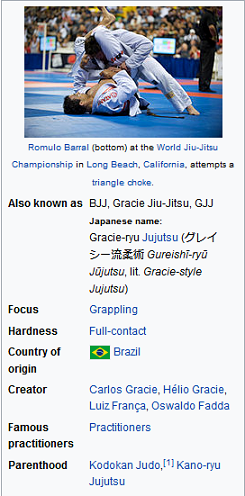
8.Aikido is a modern Japanese martial art developed by Morihei Ueshiba as a synthesis of his martial studies, philosophy, and religious beliefs. Aikido is often translated as "the way of unifying (with) life energy" or as "the way of harmonious spirit", More Information about Aikido Click Here.
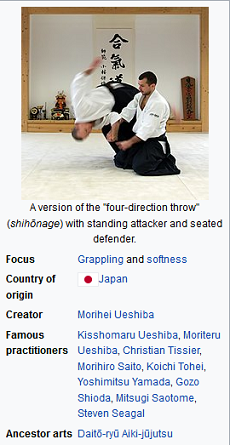
9.Muay Thai or Thai boxing is a combat sport of Thailand that uses stand-up striking along with various clinching techniques. This physical and mental discipline which includes combat on shins is known as "the art of eight limbs" because it is characterized by the combined use of fists, elbows, knees, shins, being associated with a good physical preparation that makes a full-contact fighter very efficient. Muay Thai became widespread internationally in the twentieth century, when practitioners defeated notable practitioners of other martial arts. The professional league is governed by The Professional Boxing Association of Thailand (P.A.T) sanctioned by The Sport Authority of Thailand (S.A.T.), and World Muaythai Federation (WMF) overseas, More Information about Muay Thai Click Here.
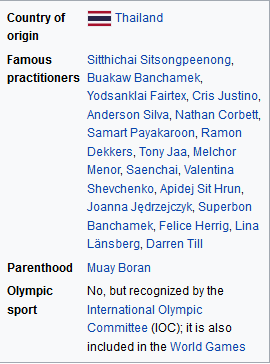
10.Jeet Kune Do, abbreviated JKD, is a hybrid philosophy of martial arts heavily influenced by the personal philosophy and experiences of martial artist Bruce Lee. Lee, who founded the system on July 9, 1967, referred to it as "non-classical", suggesting that JKD is a form of Chinese Kung Fu, yet without form. Unlike more traditional martial arts, Jeet Kune Do is not fixed or patterned, and is a philosophy with guiding thoughts. It was named for the Wing Chun concept of interception or attacking while one's opponent is about to attack. Jeet Kune Do practitioners believe in minimal movement with maximum effect. On January 10, 1996, the Bruce Lee Foundation decided to use the name Jun Fan Jeet Kune Do (振藩截拳道) to refer to the martial arts system which Lee founded; "Jun Fan" being Lee's Chinese given name, More Information about JKD Click Here.
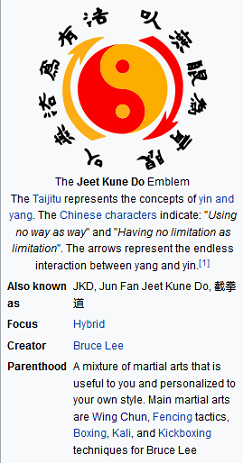
11.Judo was created as a physical, mental and moral pedagogy in Japan, in 1882, by Jigoro Kano, It is generally categorized as a modern martial art which later evolved into a combat and Olympic sport. Its most prominent feature is its competitive element, where the objective is to either throw or takedown an opponent to the ground, immobilize or otherwise subdue an opponent with a pin, or force an opponent to submit with a joint lock or a choke. Strikes and thrusts by hands and feet as well as weapons defenses are a part of judo, but only in pre-arranged forms (kata, 形) and are not allowed in judo competition or free practice (randori, 乱取り). A judo practitioner is called a judoka, More Information about Judo Click Here.
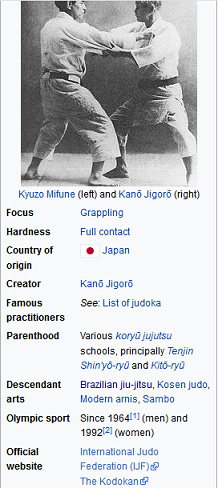
12.Mixed martial arts (MMA) is a full-contact combat sport that allows striking and grappling, both standing and on the ground, using techniques from other combat sports and martial arts. The first documented use of the term mixed martial arts was in a review of UFC 1 by television critic Howard Rosenberg in 1993. The term gained popularity when newfullcontact.com, then one of the largest websites covering the sport, hosted and republished the article. The question of who actually coined the term is subject to debate, More Information about MMA Click Here.
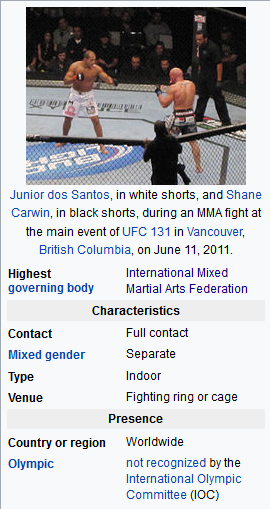
13.Capoeira is an Afro-Brazilian martial art that combines elements of dance, acrobatics, and music. It was developed in Brazil at the beginning of the 16th century. It is known for its quick and complex maneuvers, predominantly using power, speed, and leverage across a wide variety of kicks, spins, and other techniques, More Information about Capoeira Click Here.
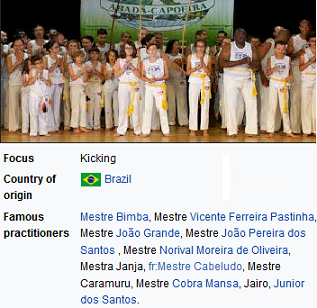
14.Qigong "Life Energy Cultivation" is a holistic system of coordinated body posture and movement, breathing, and meditation used in the belief that it promotes health, spirituality, and martial arts training. With roots in Chinese medicine, philosophy, and martial arts, qigong is traditionally viewed as a practice to cultivate and balance, it allows access to higher realms of awareness, awakens one's "true nature", and helps develop human potential,Qigong practice typically involves moving meditation, coordinating slow flowing movement, deep rhythmic breathing, and calm meditative state of mind. Qigong is now practiced throughout China and worldwide for recreation, exercise and relaxation, preventive medicine and self-healing, alternative medicine, meditation and self-cultivation, and training for martial arts, More Information about Qigong Click Here.
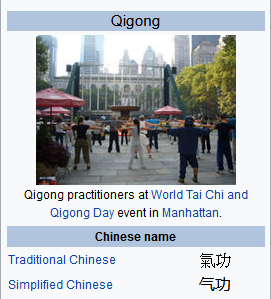
15.Kickboxing is a group of stand-up combat sports based on kicking and punching, historically developed from karate mixed with boxing. Kickboxing is practiced for self-defense, general fitness, or as a contact sport Japanese kickboxing originated in the 1960s, with competitions held since then. American kickboxing originated in the 1970s and was brought to prominence in September 1974, when the Professional Karate Association (PKA) held the first World Championships. Historically, kickboxing can be considered a hybrid martial art formed from the combination of elements of various traditional styles. This approach became increasingly popular since the 1970s, and since the 1990s, kickboxing has contributed to the emergence of mixed martial arts via further hybridization with ground fighting techniques from Brazilian jiu-jitsu and folk wrestling, More Information about Kickboxing Click Here.
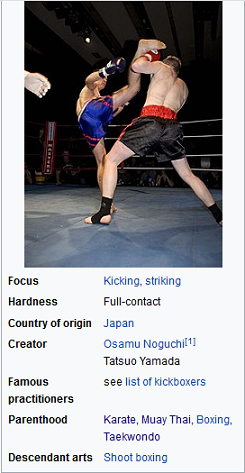
16.Sanshou (Wushu Sanshou), also known as Sanda (Wushu Sanda), Chinese boxing or Chinese kickboxing, is a Chinese self-defense system and combat sport. Wushu Sanshou is a martial art which was originally developed by the Chinese military based upon the study and practices of traditional Kung fu and modern combat fighting techniques; it combines full-contact kickboxing, which includes close range and rapid successive punches and kicks, with wrestling, takedowns, throws, sweeps, kick catches, and in some competitions, even elbow and knee strikes, More Information about Sanshou Click Here.

17.Hapkido also spelled hap ki do or hapki-do is a highly eclectic Korean martial art. It is a form of self-defense that employs joint locks, grappling, and throwing techniques similar to those of other martial arts, as well as kicks, punches, and other striking attacks. It also teaches the use of traditional weapons, including knife, sword, rope, ssang juhl bong (nunchaku), cane (ji pang ee), short stick (dan bong), and middle-length staff (joong bong, gun (analogous to the Japanese jō), and bō (Japanese)), which vary in emphasis depending on the particular tradition examined, More Information about Hapkido Click Here.
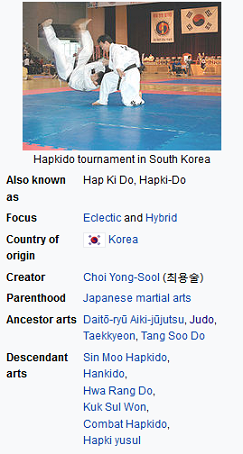
18.Kenpō is the name of several Japanese martial arts. The word kenpō is a Japanese translation of the Chinese word "quán fǎ". This term is often informally transliterated as "kempo", as a result of applying Traditional Hepburn romanization, but failing to use a macron to indicate the long vowel. The generic nature of the term combined with its widespread, cross-cultural adoption in the martial arts community has led to many divergent definitions, employs hard linear strikes and kicks, pressure point manipulation, circular movement patterns, and joint locking and breaking, More Information about Kenpō Click Here
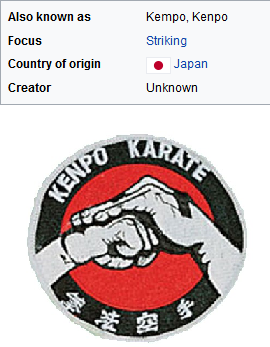
19.Kendo "sword way" is a modern Japanese martial art, which descended from swordsmanship (kenjutsu) and uses bamboo swords (shinai) and protective armour (bōgu). Today, it is widely practiced within Japan and many other nations across the world, More Information about Kendo Click Here.
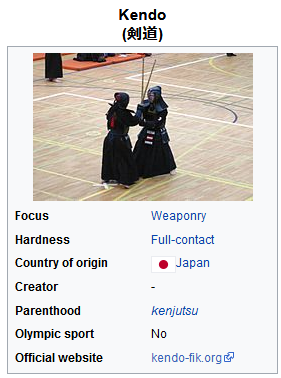
20.Shotokan is a style of karate, developed from various martial arts by Gichin Funakoshi (1868–1957) and his son Gigo (Yoshitaka) Funakoshi (1906–1945). Gichin was born in Okinawa and is widely credited with popularizing "karate do" through a series of public demonstrations, and by promoting the development of university karate clubs, including those at Keio, Waseda, Hitotsubashi (Shodai), Takushoku, Chuo, Gakushuin, and Hosei, More Information about Shotokan Click Here.
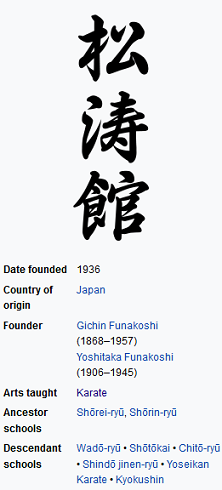
21.Stick-fighting, stickfighting, or stick fighting is a variety of martial arts which use simple long slender, blunt, hand-held, generally wooden 'sticks' for fighting; such as a staff, cane, walking stick, baton or similar. Some techniques can also be used with a sturdy umbrella or even a sword in its scabbard, More Information about Stick-fighting Click Here.
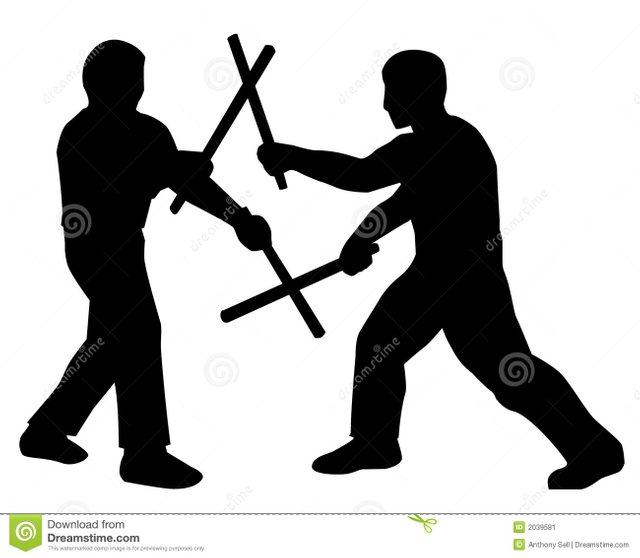
22.Silat is a collective word for a class of indigenous martial arts from a geo-cultural area of Southeast Asia encompassing most of the Nusantara, the Malay Archipelago, and the entirety of the Malay Peninsula. Originally developed in what are now Indonesia, peninsular Malaysia, south Thailand, and Singapore, it is also traditionally practised in Brunei and central Vietnam. There are hundreds of different styles (aliran) and schools (perguruan) but they tend to focus either on strikes, joint manipulation, weaponry, or some combination thereof. Silat is one of the sports included in the Southeast Asian Games and other region-wide competitions. Training halls are overseen by separate national organisations in each of the main countries the art is practised. These are Ikatan Pencak Silat Indonesia (IPSI) from Indonesia, Persekutuan Silat Kebangsaan Malaysia (PESAKA) from Malaysia, Persekutuan Silat Brunei Darussalam (PERSIB) from Brunei and Persekutuan Silat Singapura (PERSISI) from Singapore. Practitioners are called pesilat, More Information about Silat Click Here.
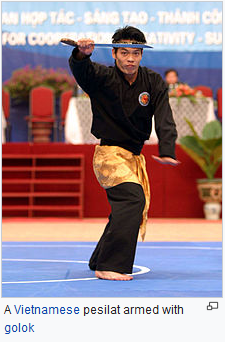
23.Shuai jiao is the term pertaining to the ancient jacket wrestling Kung-Fu style of Beijing, Tianjin and Baoding of Hebei Province in the North China Plain which was codified by Shan Pu Ying The Battalion of Excellency in Catching of the Nei Wu Fu Internal Administration Unit of Imperial Household Department, In modern usage it is also the general Mandarin Chinese term for any form of wrestling, both inside and outside China. As a generic name, it may be used to cover various styles of wrestling practised in China in the form of a martial arts system or a sport. The art was introduced to Southern China in the Republican era, More Information about Shuai jiao Click Here.
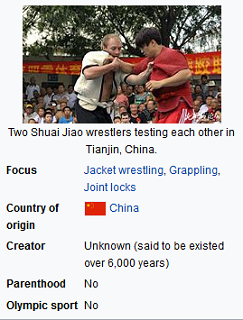
24.Chinese martial arts, often named under the umbrella terms kung fu and wushu ,are the several hundred fighting styles that have developed over the centuries in China. These fighting styles are often classified according to common traits, identified as "families", "sects" or "schools" of martial arts. Examples of such traits include Shaolinquan physical exercises involving Five Animals mimicry, or training methods inspired by Old Chinese philosophies, religions and legends. Styles that focus on qi manipulation are called internal, while others that concentrate on improving muscle and cardiovascular fitness are called "external". Geographical association, as in northern and "southern", is another popular classification method, More Information about Chinese martial arts Click Here.
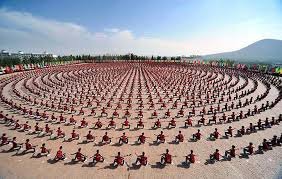
25.Five Animals Fist In the Chinese martial arts, imagery of the Five Animals Tiger, Crane, Leopard, Snake, and Dragon—appears predominantly in Southern styles, especially those associated with Guangdong and Fujian Provinces. An alternate selection which is also widely used is the crane, the tiger, the monkey, the snake, and the mantis, More Information about Five Animals Click Here.
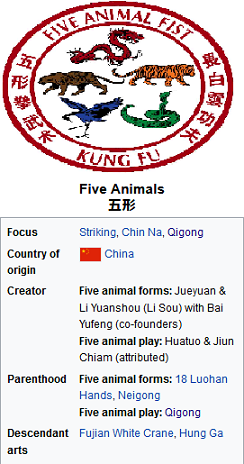
26.Baguazhang is one of the three main Chinese martial arts of the Wudang school, the other two being Taijiquan and Xing Yi Quan. It is more broadly grouped as an internal practice (or neijia quan). Bāguà zhǎng literally means "eight trigram palm," referring to the trigrams of the I Ching (Yijing), one of the canons of Taoism, More Information about Baguazhang Click Here.
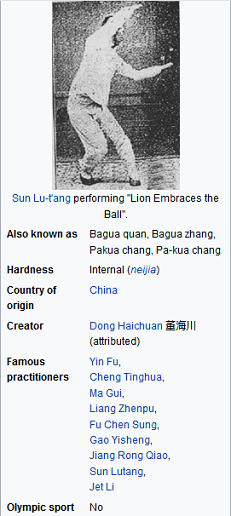
27.Hung Ga, Hung Kuen, or Hung Ga Kuen is a southern Chinese martial art (Cantonese, to be more specific), which belongs to the southern shaolin styles and associated with the Cantonese folk hero Wong Fei Hung, who was a master of Hung Ga, More Information about Hung Ga Click Here.
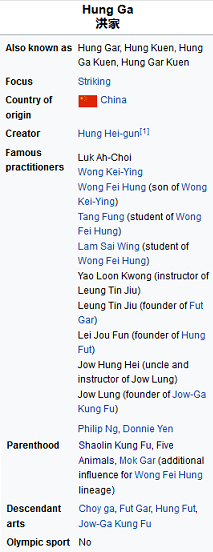
28.Xing Yi Quan is classified as one of the Wudang styles of Chinese martial arts. The name of the art translates approximately to "Form-Intention Fist", or "Shape-Will Fist", Xing Yi is characterized by aggressive, seemingly linear movements and explosive power that's most often applied from a short range. A practitioner of Xing Yi uses coordinated movements to generate bursts of power intended to overwhelm the opponent, simultaneously attacking and defending. Methods vary from school to school, but always include bare-handed fighting training (mostly in single movements/combinations and sometimes in forms) and the training of weapons usage with similar or identical body mechanics to that used for bare-handed fighting. The most basic notions of movement and body mechanics in the art were heavily influenced by the practice of staffs and spears. Historically and technically related martial arts include Dai Xin Yi Liu He Quan, Liu He Xin Yi Quan and Yi Quan, More Information about Xing Yi Quan Click Here.
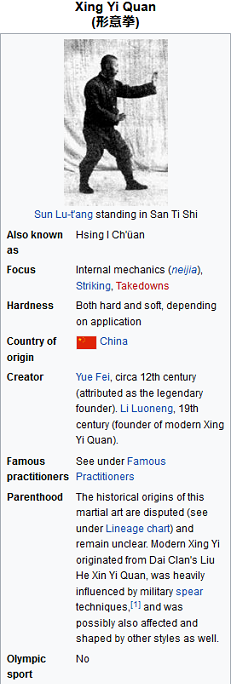
Other Posts:
Kung-Fu Is A Way Of Life
Kung-Fu Story From The Beginning
I'M Glad To Answer Your Questions ^_^